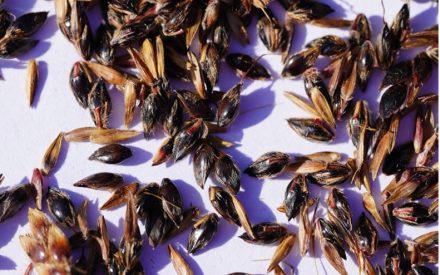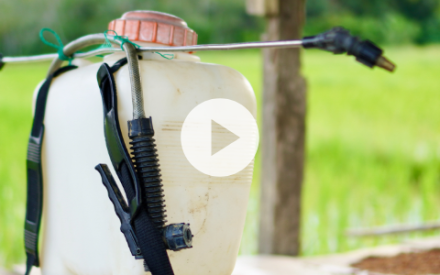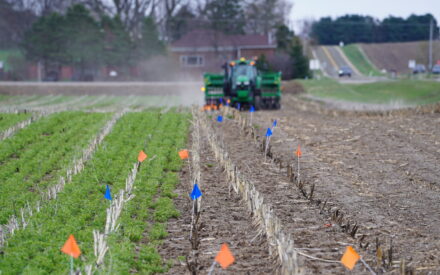As we pass the halfway point this growing season, it’s important to remember that insect pests currently in your field may also affect your in 2025 crops. Many pests lay eggs that overwinter and can cause crop damage in the subsequent year. Corn rootworm is a key pest to watch.
Northern and Western corn rootworms lay eggs that overwinter in the soil. The larvae hatch and feed on developing corn roots early in the growing season. So, you may be saying to yourself, “It’s August, these aren’t a concern anymore!” To a degree, you’d be right. At this point in the season, most corn rootworms are adults. Damage to the root zone by larval feeding is complete, and you may see the result of lodged corn in your field. The adult beetles are busy feeding on corn pollen and silks, and in some cases even the foliage. The presence of adult beetles indicates egg-laying, and we anticipate that most corn rootworm eggs will be laid throughout the month of August.
Identifying corn rootworm beetles
There are two main types of corn rootworms in Wisconsin: Northern corn rootworm and Western corn rootworm. Both adult corn rootworm species are about ¼ inch long. Northern corn rootworm beetles are typically yellowish green and do not have markings on their wings. Northern corn rootworm can be tan in color when newly emerged. Western corn rootworm beetles are yellow to light green in color and have three dark long stripes on the forewings. These stripes do not extend all the way to the wing tip. The distinctive stripes can sometimes look ‘smudged’, making the back appear blacker.

Photo of Northern corn rootworms, demonstrating range of coloration. Photo by: Adam J. Varenhorst.
While Northern corn rootworm adults are easily distinguishable, Western corn rootworm has a local look-alike. The striped cucumber beetle is often mistaken for Western corn rootworm, but the stripes on the cucumber beetle extend to the end of the abdomen.

Photo of Western corn rootworms. Photo by: J. Obermeyer, Purdue University

Photo of striped cucumber beetle, a look-alike of Western corn rootworm. Photo by: J. F. Dill, University of Maine
Identifying corn rootworm feeding damage
Adult corn rootworms feed on foliage, pollen and silks, so damage can look different depending on where the beetles are feeding. Leaf feeding appears as scars parallel to the leaf veins. Heavily damaged leaves may show a “windowpane” effect that resembles some environmental damage. Leaf damage by corn rootworm beetles is not typically considered of economic importance, but identification of foliage feeding can indicate presence in your fields.
Adult corn rootworms feed on pollen and clip corn silks, sometimes interfering with pollination and leading to economic damage. If silks are clipped to less than a ½ inch before pollination, the pollination can be incomplete. This can result in poorly filled ears and economic loss. Be aware that late-planted corn fields may be most at risk of adult corn rootworm damage. Late planted corn can attract large numbers of beetles from surrounding fields.

Photo of corn rootworm beetle feeding damage on foliage. Photo by: Robert Wright, University of Nebraska-Lincoln

Photo of Northern corn rootworm beetles feeding on corn silks. Photo by: V. Calles-Torrez, North Dakota State University
Best scouting practices for corn rootworm beetles
Scouting for adults should begin before silking and should continue until silks are dried. Corn rootworm beetles can be monitored using whole-plant counts. When scouting, first walk across the field and inspect ears. If no beetles are found, return to the field 3-5 days later and walk again across the field and inspect ears. If beetles are found, sample two plants at 12 locations throughout the field. The two plants should be at least 5 feet apart, and each location should be approximately 100 feet apart. Avoid scouting plants on field edges as these areas may overestimate the number of adults in the field.
When approaching each corn plant, take caution not to disturb the beetles to ensure an accurate count. Cover the ear tip to prevent beetles from escaping while you look for beetles beginning at the bottom of the plant. Make sure to look at all surfaces of the leaves and leaf axils, then gently open the ear top to look for beetles in the silks. Beetles are often most abundant on the silks. Record the number of Western corn rootworm and Northern corn rootworm beetles on each plant and take note of plants with silks clipped to within ½ inch.
If you’re noticing adult corn rootworms in high numbers consistently throughout your field, it isn’t necessary to complete detailed counts. High abundance indicates a likelihood of infestation in the following year.
How to manage adult corn rootworms if they’re an immediate problem
Control of adult corn rootworms is usually not necessary, but evaluating the adult pressure within your field can be a good indicator whether corn rootworms may be an issue in the following growing season, especially in corn on corn and corn-soybean rotations.
If your goal is to protect silks during pollination, a treatment may be justified if populations reach >5 corn rootworm beetles per plant, silks are clipped within ½ inch and pollination is less than 50% complete. Using foliar insecticides to reduce egg-laying is usually not economically beneficial or recommended, as application timing is difficult and often requires multiple treatments. Always apply insecticides according to label instructions and consider factors such as application method, rate, and pre-harvest intervals. Refer to A3646, Pest Management in Wisconsin Crops, for corn rootworm beetle insecticide recommendations in corn (p. 63-64).
Looking forward to the next growing season
Scouting now for adult corn rootworm beetles helps you determine if there is a need to control corn rootworm next year. It will also help you choose the appropriate control method. If you found >0.75 beetles per plant during the previous corn crop year, you will need to use a corn rootworm control tactic next season.
Rotate your crop to soybean or a non-host crop. Crop rotation is the easiest way to disturb corn rootworm populations. Larvae will perish soon after hatching if a crop other than corn is planted where the eggs were laid. Be aware that Western corn rootworm beetles have started adapting to the corn-soybean rotation. Adults will travel to the edges of soybean fields to lay their eggs, creating issues when the following crop is corn.
Consider using soil-applied insecticides at planting with a conventional, non-Bt corn rootworm hybrid. Refer to Pest Management in Wisconsin Crops (A3646), for corn rootworm insecticide recommendations in corn (p. 64).
Rotate Bt and RNAi corn rootworm traits. Annual rotation of Bt and RNAi toxins as traits, whether single, stacked or pyramided, is preferred to prevent resistance to Bt corn hybrids. To better understand available trait packages for US corn production, consult the “The Handy Bt Trait Table” in Pest Management in Wisconsin Crops (A3646) (p. 57-58).
Consider using a high rate of a neonic seed treatment to control corn rootworm if low to moderate beetle populations were observed during scouting the previous year.
Implement a long-term integrated pest management program for corn rootworm. Combinations of chemical and cultural controls can be very effective in managing rootworm populations and improving your crop.

 Johnsongrass in Wisconsin
Johnsongrass in Wisconsin ▶ Backpack Sprayers in Diversified Vegetable Systems
▶ Backpack Sprayers in Diversified Vegetable Systems ▶ AI in Agriculture
▶ AI in Agriculture ▶ Considerations for 2026 Seed Selection
▶ Considerations for 2026 Seed Selection


